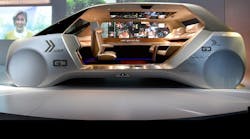The Drive to Survive: What Matters in Automotive's Age of Disruption
Everywhere automotive manufacturers turn, there are signs suggesting the business models on which they have long relied are going the way of the 1970s-era classic Ford Pinto.
Consider the following:
• Ride-hailing company Lyft is partnering with Magna, North America’s largest Tier 1 auto parts supplier, to build self-driving vehicles.
• Chinese manufacturers, many virtually unknown outside their home country, are leading the global electric vehicle movement, unencumbered by legacy commitments to traditional internal-combustion vehicles.
• High-end vacuum cleaner manufacturer Dyson, a company with no automotive background, reportedly plans to roll out not one but three electric vehicle models starting in 2020 or 2021.
• 16.5% of car-owning Millennials are rethinking car ownership because services such as Lyft are available, according to a survey by lendedu.com; 42.5% would give up manually driving themselves in favor of a self-driving vehicle; half would prefer to buy a “green” car over a traditional vehicle.
Signs like these are pointing some OEMs and automotive suppliers toward new business models that bundle traditional products with digital products and services, and involve business alliances that would have been difficult to envision just a decade ago. These new models, and the business relationships that underpin them, respond directly to the disruptive forces and shifting consumer preferences that are reshaping transportation markets.
Instead of being structured around ICE, the internal combustion engine, the business models we’re seeing emerge focus on another acronym: CASE, short for connected, autonomous, shared services, and electric.
For automotive manufacturers, the move to CASE is in part a drive to survive in a new world transportation order. The new world demands that automotive companies redefine their skills and competencies with digital, data-driven technologies like artificial intelligence, machine learning and the Internet of Things. It demands that they use technology to significantly shorten product development cycles to behave more like a startup or a tech company.
Here’s a look at some of the competitive angles automotive manufacturers are working, and the digital technologies they’re using, to make a CASE for remaining an integral part of our transportation future:
Connected. Telecom giant AT&T says it has added at least one million connected cars to its network during each of the last 11 quarters, bringing the total number of connected cars in its network to 17.8 million.
The emerging generation of networked, sensor-laden vehicles gives manufacturers the means to establish and deepen relationships with customers. They now can connect directly to drivers with apps to offer vehicle-centric services that can build customer satisfaction, loyalty and retention. Meanwhile, the massive amounts of sensor-generated data on the car itself, its surroundings and driver behavior can be harvested and analyzed, not only to provide an intelligent, automated experience for consumers, but also to identify new revenue-generating areas.
Maintenance is one of those areas. A connected car can alert a driver and nearby repair facilities to a mechanical problem and identify whether the vehicle needs immediate attention or regular maintenance. A service appointment can be automatically scheduled, and related offers, such as a replacement rental car while a customer’s vehicle is in the shop, can be sent to the driver. Then the cost for maintenance or repair can automatically be added to a lease or loan payment.
To further fortify the bundle, a telecom company like AT&T can extend its services through offers of convenient and relevant purchases to the same drivers, and charge them directly to the person’s phone bill.
Offerings such as these are just the beginning. Imagine a day when all vehicles on the road are connected, and the data they provide in real-time is used to optimize routes, traffic flow and the transportation of goods from point to point.
The prerequisite to all this is a powerful digital platform that collects, maps, stores and analyzes vehicle and equipment data in real-time, then integrates that data with operational and transactional business and customer data to reveal new opportunities. Such a platform is key to creating a new revenue streams and shortening time to market for connected car product and service offerings.
Autonomous. A relative latecomer to the Race for CASE among automakers, Toyota jumped in by investing $1 billion to launch a research institute to focus on automotive applications of AI. It also has been busy with strategic alliances, mergers and acquisitions. In March 2018, through its new Toyota AI Ventures venture capital unit, it invested in Blackmore Sensors & Analytics, a Montana company that makes compact LiDAR sensors and analytic tools to help autonomous vehicles “see” their surroundings. A month prior that same unit invested in May Mobility,* a Michigan startup that is looking to take its self-driving microtransit shuttle service national following a successful pilot in 2017 with low-speed, electric Polaris GEM vehicles.
True to Brecht’s CASE vision, Daimler has been integrating AI into new Mercedes models via an intelligent virtual assistant, through which customers can get an answer in real time to their questions about operating their vehicle using the “Ask Mercedes” app. An augmented reality feature embedded in the app lets users get to know their vehicle better.
Shared mobility and services. A wide range of transportation-focused, digitally enabled product and service bundles are stoking consumer imaginations—and buying behaviors—by making it easy for connected car drivers and passengers to get what they need: fuel (or for electric vehicle drivers, a charge); a parking space, convenience items, perhaps even a hotel room right off the highway for a weary road-tripper.
Cloud-based global networks are serving as marketplaces for connected car apps and services, seamlessly and instantly linking consumers with the services they may need, be it parking, food, fuel or more, at the moment they need them. Connectivity enables conveniences like mobile payment and integration with navigation systems and maps. It also generates many opportunities for up-selling and cross-selling products and services.
Such a network ecosystem might include dozens of bundles. The network platform itself makes it possible by standardizing business processes and enabling integration and collaboration. That in turn facilitates new revenue streams and opportunities for businesses in the network.
Electric. Less than one year on from Volvo’s announcement in mid-2017 that it would stop making internal-combustion-only vehicles and equip all its units with electric motors starting in 2019, the ascendance of the electric drivetrain continues, as traditional ICE-focused manufacturers seek to gain a foothold in the burgeoning EV marketplace alongside upstart vehicle and parts manufacturers that are focused exclusively on EV products. Newly invigorated by a partnership with one of China’s foremost traditional automakers, FAW, the Chinese EV startup Byton is poised to enter global markets with a vehicle it says will cost 40% less than Tesla’s Model X EV. The concept SUV that Byton unveiled at the Consumer Electronics Show earlier this year features facial recognition access, assistive driving technologies and hand gesture controls. It’s expected to debut in China next year, and in the U.S. and Europe in 2020.
Byton is among several dozen Chinese electric vehicle startups vying for position in the race for CASE. The strategic maneuvers that they and their competitors are making today in the areas of connectivity, autonomous vehicles, shared mobility, services and electric drivetrains will go a long way in determining winners and losers in that high-stakes race.
Uli Muench is global vice president, automotive business unit for SAP Automotive, an enterprise software company.
*The original version of this article incorrectly stated that Toyota AI acquired Blackmore Sensors & Analytics and May Mobility.




